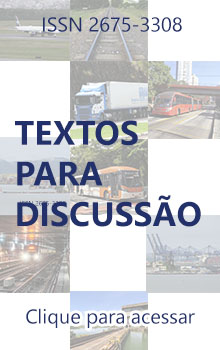TRABALHO POR APLICATIVO NA REGIÃO METROPOLITANA DE CURITIBA: UMA PROPOSTA PARA A MENSURAÇÃO DO FENÔMENO NO SETOR DE TRANSPORTES
<<< retornar ao índice do Dossiê
TRABALHO POR APLICATIVO NA REGIÃO METROPOLITANA DE CURITIBA: UMA PROPOSTA PARA A MENSURAÇÃO DO FENÔMENO NO SETOR DE TRANSPORTES
APP-BASED WORK IN THE METROPOLITAN REGION OF CURITIBA: A PROPOSAL FOR MEASURING THE PHENOMENON IN THE TRANSPORTATION SECTOR
Autor: Thiago Magalhães Borges
Resumo: As plataformas de mobilidade e entrega de encomendas se difundiram na Região Metropolitana de Curitiba (RMC) ao longo da segunda década dos anos 2000, seguindo a tendência global de difusão do trabalho por aplicativo. A quantificação de trabalhadores envolvidos nessas atividades é um dos principais desafios enfrentados, devido à informalidade. Este estudo aplica a metodologia proposta por Góes, Firmino e Martins (2021) para projetar o número de trabalhadores por conta própria no setor de transportes de passageiros e mercadorias, potencialmente demonstrando o crescimento desta modalidade de trabalho em âmbito regional. Com base nos microdados da PNADC de 2014 a 2023, foi possível constatar aumento substancial do número de trabalhadores por conta própria atuando nas atividades de transporte de passageiros e de mercadorias, superando o crescimento do emprego total e do emprego informal para o mesmo período. Para o ano de 2022, o método testado apresenta resultados significativamente próximos da pesquisa suplementar voltada ao trabalho por aplicativo, realizada pelo IBGE no ano em questão. Conclui-se que, embora o método utilizado apresente limitações por não diferenciar trabalhadores informais dos transportes não vinculados às plataformas, ele pode ser utilizado à critério de estimação diante da falta de informações mais substanciais.
Abstract: mobility and delivery platforms became widespread in the Curitiba Metropolitan Region (MRC) during the second decade of the 2000s, in line with a global trend towards app-based work. Quantifying the workers involved in these activities is one of the main challenges faced, due to the informality. This study applies the methodology proposed by Góes, Firmino and Martins (2021) to project the number of self-employed workers in the passenger and goods transportation sector, potentially demonstrating the growth of this type of work at a regional level. Based on PNADC microdata from 2014 to 2023, it was possible to see a substantial increase in the number of self-employed workers in passenger and goods transportation, outstripping the growth in total employment and informal employment for the same period. For the year 2022, the method tested shows results that are significantly close to the supplementary survey on app-based work carried out by IBGE in the year in question. The conclusion is that, although the method used has limitations in terms of not differentiating between informal workers and transport workers not linked to platforms, it can be used as an estimation criterion given the lack of more substantial information.
Palavras-chave: Mercado de Trabalho; Trabalho por aplicativo; Economia das Plataformas.
Keywords: Labor market; App-based work; Platform economy.
Referências
REFERÊNCIAS
BOM GOURMET. Mais de 30 restaurantes de Curitiba estão cadastrados no aplicativo gratuito; o cliente recebe confirmação do pedido em até três minutos. [S. l.], 2013. Disponível em: https://bomgourmet.com/bomgourmet/restaurantes/aplicativo-para-celular-permite-pedir-comida-on-line/. Acesso em: 24 set. 2024.
DE STEFANO, Valerio. The Rise of the “Just-in-Time Workforce”: On-Demand Work, Crowd Work and Labour Protection in the “Gig-Economy”. International Labour Office Conditions of work and employment series, [s. l.], v. 71, 2016.
G1 PR. Uber começa a funcionar em Curitiba em meio a discussões no Legislativo. [S. l.], 2016. Disponível em: https://g1.globo.com/pr/parana/noticia/2016/03/uber-comeca-funcionar-em-curitiba-em-meio-discussoes-no-legislativo.html. Acesso em: 24 set. 2024.
GÓES, Geraldo; FIRMINO, Antony; MARTINS , Felipe. A Gig economy no Brasil: uma abordagem inicial para o setor de transporte. CARTA DE CONJUNTURA IPEA, [s. l.], v. NÚMERO 53, n. NOTA DE CONJUNTURA 5, 4 ° TRIMESTRE DE 2021, p. 1–13, 2021.
IBGE. Microdados Pesquisa Nacional por Amostra de Domicílios Contínua. [S. l.], 2024. Disponível em: https://ftp.ibge.gov.br/Trabalho_e_Rendimento/Pesquisa_Nacional_por_Amostra_de_Domicilios_continua/Trimestral/Microdados/. Acesso em: 24 set. 2024.
MORAES, Rodrigo Bombonati de Souza; OLIVEIRA, Marco Antonio Gonsales de; ACCORSI, André. UBERIZAÇÃO DO TRABALHO: A PERCEPÇÃO DOS MOTORISTAS DE TRANSPORTE PARTICULAR POR APLICATIVO. Revista Brasileira de Estudos Organizacionais, [s. l.], v. 6, n. 3, p. 647–681, 2019.
RANI, Uma; GOBEL, Nora. PLATFORMS, LABOUR, AND MOBILITY: Migration and the gig economy. In: THE ROUTLEDGE HANDBOOK OF THE GIG ECONOMY. Oxon: Routledge, 2023. p. 180–190.
URBS. Informações gerais sobre o Serviço de Transporte Individual de Passageiros (Táxi). [S. l.], 2024. Disponível em: https://www.urbs.curitiba.pr.gov.br/transporte/taxis. Acesso em: 20 set. 2024.








